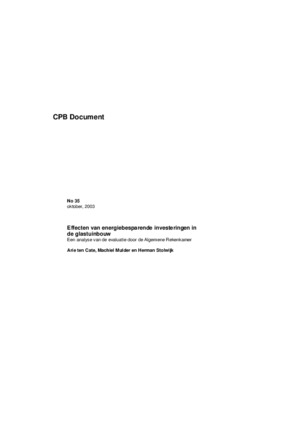Effects of energy-saving investments in horticulture under glass; analysing the evaluation by the Court of Audit
CPB: conclusies AR over energiebesparing glastuinbouw niet goed onderbouwd
We are sorry, unfortunately there is no English translation of this page.
Methodological doubts regarding this research are the immediate cause for this request of the Minister. The key question in the analysis of CPB is whether the main conclusion of the AR is justified given the methods and data used. The AR has concluded that most investments in energy saving by horticultural firms are ineffective, in the sense that they do not have a significant effect on energy efficiency. In addition, the AR recommends aiming government policies at the behaviour of growers in order to improve the effectiveness of energy-saving techniques.
We substantiate that the conclusion of the AR is contrary to many indications from several other sources. The past development of the Dutch horticulture under glass shows a sector operating on a highly competitive market. If firms would have invested significant amounts of money without realising any economic effect, they would probably not have survived. Instead, they have shown a remarkably strong economic growth in the past decades. Moreover, such an irrational behaviour conflicts with basic notions of economic theory. Finally, the literature on this topic comprises a large number of studies showing effects of investments in energy-saving techniques on energy efficiency at the level of the individual firm.
We conclude that the somewhat striking conclusion of the AR is the result of a number of inadequacies in the method of research:
- the level of aggregation of the data is too high;
- errors have been made in calculating the primary energy use of electricity and heat;
- no attention has been paid to the simultaneous relations between energy efficiency and investments;
- the estimation procedure does not pay sufficient attention to differences among firms.
Finally, the AR has interpreted statistical results not correctly. Estimation results which are 'statistically insignificant' have been viewed by the AR as indications for the absence of any effect. However, 'insignificant' estimation results imply that no explicit statement can be made about the value of the effect.
Given these shortcomings in the research of the AR, it is obvious not a good example of ex post policy analysis. This does not imply that the method as such - micro-econometrical research - is unsuitable for policy analysis. Results of that kind of research should, however, always be assessed in the light of theoretical and empirical pieces of evidence from other sources.
This publication is in Dutch.
